Takeshi Konomi’s long running manga and anime series, The Prince of Tennis, has been brought to America as part of the Shonen Jump line-up. Following 7th grade tennis prodigy, Ryoma Echizen, we watch Seishun Gakuen Middle School’s tennis team get shaken up by the addition of the younger player to its highly praised first string team for inter-school and national competitions. Seigaku, as the school is more commonly known as, presents a mixture of personalities and tennis styles and the addition of Ryoma is going to be no exception. Viz Media introduces us to the 178 episode TV series with The Prince of Tennis Box 1: The Prince Appears.Â
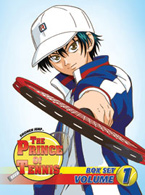 Stats
Stats
DVD: The Prince of Tennis Box 1: The Prince Appears
Release Date: 4/24/2007
Release Studio: Viz Media
ADR Production: Salami Studios
MSRP: $39.98
Audio: English 2.0 DD, Japanese 2.0 DD
Subtitles: English
Episodes: 13
Runtime: 325mins
Extras: Textless Opening & Closing, Character Sketch Art, Preview Trailers
Notes: Review is based on a Screener copy of the final product.
With sports series, you are either going to love or hate a title by its introduction arc. This is because the plot is often strung out along multiple episodes that focus on the sport with hints of each character’s personality sprinkled in. The Prince of Tennis is no different, with the bulk of Box 1 showing off Ryoma Echizen as both a tennis prodigy and a cocky little brat. However, the cast of supporting characters and Ryoma’s own true personality do come out as we enter into the final disc in this set. Try to keep this in mind if this set is your first introduction to the world of The Prince of Tennis.
Disc 1
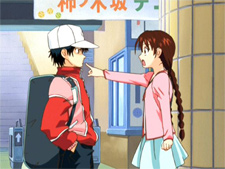 The introduction episode sets up a few of the regular characters, like Seigaku’s coach Sumire Ryuzaki and her granddaughter Sakuno, in addition to providing a glimpse into Ryoma Echizen’s power. Having played tennis in competitions and with his father, Ryoma enters a tournament in Japan to get a feel for the atmosphere of the Japanese court. On his way there, he happens to inadvertently save Sakuno from a lame older-boy named Sasabe practicing his swing on the subway. Naturally, the guy and his two friends take kindly to a cocky-little-brat telling them to stop making so much noise. But before the trio can do anything, Ryoma gets off at the train stop. Of course, Ryoma is new to the area and doesn’t know how to get to the courtyard holding the tournament. He happens to run across Sakuno inside the station, but by accident she gives him the wrong directions which make him too late for his entry into the contest. But all is not lost, because those three baffoons from the subway ride are also here and their shamed leader wants a crack at Ryoma… on the court. You can guess how this is going to turn out as Ryoma reveals just how knowledgeable he is about the sport.
The introduction episode sets up a few of the regular characters, like Seigaku’s coach Sumire Ryuzaki and her granddaughter Sakuno, in addition to providing a glimpse into Ryoma Echizen’s power. Having played tennis in competitions and with his father, Ryoma enters a tournament in Japan to get a feel for the atmosphere of the Japanese court. On his way there, he happens to inadvertently save Sakuno from a lame older-boy named Sasabe practicing his swing on the subway. Naturally, the guy and his two friends take kindly to a cocky-little-brat telling them to stop making so much noise. But before the trio can do anything, Ryoma gets off at the train stop. Of course, Ryoma is new to the area and doesn’t know how to get to the courtyard holding the tournament. He happens to run across Sakuno inside the station, but by accident she gives him the wrong directions which make him too late for his entry into the contest. But all is not lost, because those three baffoons from the subway ride are also here and their shamed leader wants a crack at Ryoma… on the court. You can guess how this is going to turn out as Ryoma reveals just how knowledgeable he is about the sport.
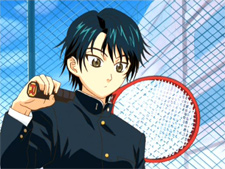 The next two episodes follow Ryoma’s first days at Seishun Gakuen Middle School as everyone around him keeps assuming that he’s a normal 7th grader wanting to join the school’s tennis team. Mamoru Inoue of Monthly Tennis is itching to find out who Seigaku’s up-and-coming players will be by and asks Sumire who she thinks is going to make it. Inoue, a big fan of Seigaku’s famous Nanjiro “The Samurai” Echizen, is in for a surprise when he spots the junior Samurai on the courts. We also get to meet one of Ryoma’s fellow 7th graders, Satoshi Horio, who is quick to tell everyone about his two years of tennis practice, but has no real talent on the court.
The next two episodes follow Ryoma’s first days at Seishun Gakuen Middle School as everyone around him keeps assuming that he’s a normal 7th grader wanting to join the school’s tennis team. Mamoru Inoue of Monthly Tennis is itching to find out who Seigaku’s up-and-coming players will be by and asks Sumire who she thinks is going to make it. Inoue, a big fan of Seigaku’s famous Nanjiro “The Samurai” Echizen, is in for a surprise when he spots the junior Samurai on the courts. We also get to meet one of Ryoma’s fellow 7th graders, Satoshi Horio, who is quick to tell everyone about his two years of tennis practice, but has no real talent on the court.
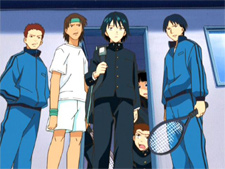 After saving his fellow classmates from being picked on by some of the older school-tennis-club members, Ryoma is challenged to a match by the good-natured Takeshi Momoshiro. The pair have an interesting battle, but Momo knows that his injured ankle influenced Ryoma to go easy on him. The next day brings even more trouble as Ryoma’s reputation as a cocky brat and an ace on the court is starting to get around. Naturally, some more of the tennis club’s older students want a crack at the prodigy to show him up. Masashi Arai and his buddies would love to bring Ryoma down a peg or two, and the group steals Ryoma’s bag of tennis racquets before issuing a challenge. Left with only an old, shoddy racquet to use, Ryoma turns the disadvantage into a strnegth, getting Arai and his buddies to back off. Coach Ryuzaki is amused by Ryoma’s ability to face a challenge, and is even more amused that Seigaku’s team captain, Kunimitsu Tezuka, is willing to bend the “no first year students” rule to allow Ryoma to enter the monthly competition for spots on Seigaku’s first-string team.
After saving his fellow classmates from being picked on by some of the older school-tennis-club members, Ryoma is challenged to a match by the good-natured Takeshi Momoshiro. The pair have an interesting battle, but Momo knows that his injured ankle influenced Ryoma to go easy on him. The next day brings even more trouble as Ryoma’s reputation as a cocky brat and an ace on the court is starting to get around. Naturally, some more of the tennis club’s older students want a crack at the prodigy to show him up. Masashi Arai and his buddies would love to bring Ryoma down a peg or two, and the group steals Ryoma’s bag of tennis racquets before issuing a challenge. Left with only an old, shoddy racquet to use, Ryoma turns the disadvantage into a strnegth, getting Arai and his buddies to back off. Coach Ryuzaki is amused by Ryoma’s ability to face a challenge, and is even more amused that Seigaku’s team captain, Kunimitsu Tezuka, is willing to bend the “no first year students” rule to allow Ryoma to enter the monthly competition for spots on Seigaku’s first-string team.
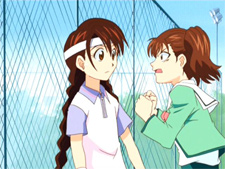 The final episode for disc 1 introduces the monthly school competition for the tennis club. To keep the first-string team competitive, all of the slots to join the school’s team for inter-school and national competitions are open to the winners in their competition brackets. Ryoma takes his entry into the contest as nonchalantly as he has taken rest of the challenges thus far. Breezing through the early players, the first true player to face Ryoma is regular Seigaku team-member Kaoru “Viper” Kaido, known for his beady eyes, hissing, and snake-attack-like moves on the court. Ryoma is actually in for some competition.
The final episode for disc 1 introduces the monthly school competition for the tennis club. To keep the first-string team competitive, all of the slots to join the school’s team for inter-school and national competitions are open to the winners in their competition brackets. Ryoma takes his entry into the contest as nonchalantly as he has taken rest of the challenges thus far. Breezing through the early players, the first true player to face Ryoma is regular Seigaku team-member Kaoru “Viper” Kaido, known for his beady eyes, hissing, and snake-attack-like moves on the court. Ryoma is actually in for some competition.
Disc 2
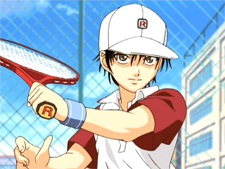 Continuing from the Kaido/Echizen match of Episode four, we find our first-year player taking the challenge from Kaido seriously as he switches to his dominant left hand. The 7th graders, coach Ryuzaki, Mamoru Inoue, and Mamoru’s photographer/assistant Saori Shiba watch on as Ryoma begins to figure out how to deal with Kaido’s “Snake Shot” on the court. Kaido isn’t giving up easily, wearing Ryoma down physically by having him run all over the court. But does Kaido realize that the pupil of Nanjiro Echizen may know more than he ever lets on? Only Seigaku first-team member Sadaharu Inui could tell you for sure with his analytical nature. Studying up on Ryoma, Inui is prepared to take on the genius player in a way Ryoma has never faced before.
Continuing from the Kaido/Echizen match of Episode four, we find our first-year player taking the challenge from Kaido seriously as he switches to his dominant left hand. The 7th graders, coach Ryuzaki, Mamoru Inoue, and Mamoru’s photographer/assistant Saori Shiba watch on as Ryoma begins to figure out how to deal with Kaido’s “Snake Shot” on the court. Kaido isn’t giving up easily, wearing Ryoma down physically by having him run all over the court. But does Kaido realize that the pupil of Nanjiro Echizen may know more than he ever lets on? Only Seigaku first-team member Sadaharu Inui could tell you for sure with his analytical nature. Studying up on Ryoma, Inui is prepared to take on the genius player in a way Ryoma has never faced before.
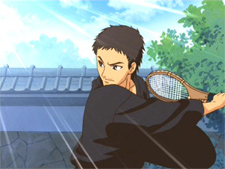 Episode six gives the first real look into Ryoma’s background as the school tournament takes a day off. Sakuno Ryuzaki spends the day looking for Ryoma to ask for his assistance with her swing while Inoue and Shiba go looking for “The Samurai” himself to ask about Ryoma. At the Echizen home we find a monk-ish dressed man who happens to be a bit of a letch. Nanjiro’s niece plays as a good foil to Nanjiro’s attempts to blow off the reporters about being the real Nanjiro Echizen. In a little challenge, Inoue gets to take on one of his favorite players on the court in an attempt to find out why the Samurai quit playing and what drives Ryoma. Meanwhile, Sakuno manages to find where Ryoma has run off to for the day to keep practicing tennis on his own. The conversation between the tennis prodigy and his somewhat-infatuated female friend is an interesting revelation over the how and why of tennis in Ryoma’s life.
Episode six gives the first real look into Ryoma’s background as the school tournament takes a day off. Sakuno Ryuzaki spends the day looking for Ryoma to ask for his assistance with her swing while Inoue and Shiba go looking for “The Samurai” himself to ask about Ryoma. At the Echizen home we find a monk-ish dressed man who happens to be a bit of a letch. Nanjiro’s niece plays as a good foil to Nanjiro’s attempts to blow off the reporters about being the real Nanjiro Echizen. In a little challenge, Inoue gets to take on one of his favorite players on the court in an attempt to find out why the Samurai quit playing and what drives Ryoma. Meanwhile, Sakuno manages to find where Ryoma has run off to for the day to keep practicing tennis on his own. The conversation between the tennis prodigy and his somewhat-infatuated female friend is an interesting revelation over the how and why of tennis in Ryoma’s life.
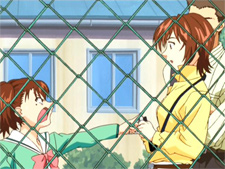 The final two episodes on disc 2 cover the tennis match between Inui and Echizen. Up until now the competition has been fairly light, with the exception of one of Seigaku’s finest to play against. But the possible ultimate-test is now facing Ryoma as he plays against a man who can predict his every movement on the court. Fighting a man who can be his doppelganger throws Ryoma’s game off quickly and forces the player to re-examine how to approach what is, essentially, himself on the other side of the court. Ryoma, unwilling to give up yet, pulls out a secret he was saving for the nationals: the split step. With more agility on the court and the wits to throw off Inui’s researched plan, Ryoma presents a new challenge for a spot on the coveted first-team.
The final two episodes on disc 2 cover the tennis match between Inui and Echizen. Up until now the competition has been fairly light, with the exception of one of Seigaku’s finest to play against. But the possible ultimate-test is now facing Ryoma as he plays against a man who can predict his every movement on the court. Fighting a man who can be his doppelganger throws Ryoma’s game off quickly and forces the player to re-examine how to approach what is, essentially, himself on the other side of the court. Ryoma, unwilling to give up yet, pulls out a secret he was saving for the nationals: the split step. With more agility on the court and the wits to throw off Inui’s researched plan, Ryoma presents a new challenge for a spot on the coveted first-team.
Disc 3
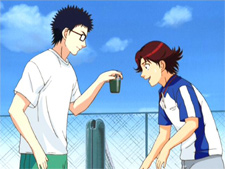 Finishing off Inui and a handful of minor players, Ryoma has snatched up one of the first-team slots for Seigaku. But this isn’t the only surprising news, as Kaido takes home his very first win against Inui. Until now, Inui has always been able to foil the Viper’s attacks, but a renewed Kaido puts Inui away with an even more ferocious attack on the court. With the eight slots picked for the month, Ryoma finds himself in a new world as everyone wants to congratulate him on his victory. Sakuno also wants to congratulate her friend, but hasn’t found the right time with everyone always around. Since Inui didn’t make the team, he has taken up the duty of assisting coach Ryuzaki with whipping the eight into shape for competitions. What’s the only thing worse than playing against Inui? Choking down his health drink when you mess up on the court.
Finishing off Inui and a handful of minor players, Ryoma has snatched up one of the first-team slots for Seigaku. But this isn’t the only surprising news, as Kaido takes home his very first win against Inui. Until now, Inui has always been able to foil the Viper’s attacks, but a renewed Kaido puts Inui away with an even more ferocious attack on the court. With the eight slots picked for the month, Ryoma finds himself in a new world as everyone wants to congratulate him on his victory. Sakuno also wants to congratulate her friend, but hasn’t found the right time with everyone always around. Since Inui didn’t make the team, he has taken up the duty of assisting coach Ryuzaki with whipping the eight into shape for competitions. What’s the only thing worse than playing against Inui? Choking down his health drink when you mess up on the court.
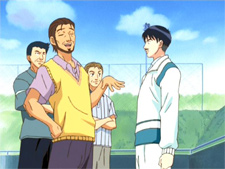 The next episode takes a break as the 7th graders and Momo get to visit a country club tennis court to practice thanks to Kachiro’s father, Sato. However, one of the members is Sasabe, and his father is an even bigger asshole on the court than he is. After pushing around Sato and shaming him in front of everyone, Ryoma decides to intercede between the club pro and cocky member. Ryoma takes advantage of their egos and puts Sasabe’s father, the “Golden Retriever of Meguro,” away after stringing the old man and his son along for a while on the court.
The next episode takes a break as the 7th graders and Momo get to visit a country club tennis court to practice thanks to Kachiro’s father, Sato. However, one of the members is Sasabe, and his father is an even bigger asshole on the court than he is. After pushing around Sato and shaming him in front of everyone, Ryoma decides to intercede between the club pro and cocky member. Ryoma takes advantage of their egos and puts Sasabe’s father, the “Golden Retriever of Meguro,” away after stringing the old man and his son along for a while on the court.
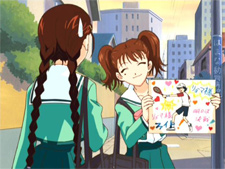 Episode eleven is interesting for the very fact that, aside from his conversation with Sakuno previously, this is the first time Ryoma acts more like a regular person than just a cocky brat who can play tennis. The district prelims are coming up soon for the Metropolitan and one of the eight members is going to have to sit out the competition as a reserve player. Coach Ryuzaki toils over who should be in the third singles slot and who should fill the last doubles slot. Meanwhile, Ryoma and Momo run into each other at a fast-food joint. The competition heats up quickly, starting with who can eat the most food. The boys take the challenge even further that night trying to find a court to settle who, between the two of them, deserves the last singles spot on the roster. But in the middle of the city at night there are only a few lit spots and the one nearby is for doubles only. The two join up to clear the challengers so that they can settle their match afterwards, but they quickly discover that they complement each other when playing together. The trouble gets even worse when an unknown street-pair show up and dominate the court after Ryoma and Momo had been doing so well. The two know what they must do to be a part of the prelims.
Episode eleven is interesting for the very fact that, aside from his conversation with Sakuno previously, this is the first time Ryoma acts more like a regular person than just a cocky brat who can play tennis. The district prelims are coming up soon for the Metropolitan and one of the eight members is going to have to sit out the competition as a reserve player. Coach Ryuzaki toils over who should be in the third singles slot and who should fill the last doubles slot. Meanwhile, Ryoma and Momo run into each other at a fast-food joint. The competition heats up quickly, starting with who can eat the most food. The boys take the challenge even further that night trying to find a court to settle who, between the two of them, deserves the last singles spot on the roster. But in the middle of the city at night there are only a few lit spots and the one nearby is for doubles only. The two join up to clear the challengers so that they can settle their match afterwards, but they quickly discover that they complement each other when playing together. The trouble gets even worse when an unknown street-pair show up and dominate the court after Ryoma and Momo had been doing so well. The two know what they must do to be a part of the prelims.
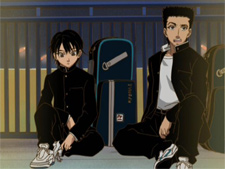 The last two episodes for this box take us into the Metropolitan prelims. Gyokurin Middle School is the first challenger for Seigaku and a certain pair of doubles players, Izumi and Fukawa, happen to be the same street-players from the other day. Ryoma and Momo have solved their previous court issues playing against the pair from Gyokurin, but that doesn’t last long as it becomes clear that you just can’t pick up doubles in a couple of days. With their sync fairly off, the Seigaku stars fall behind with every attack from Izumi and Fukawa. Only falling back to their natural strengths on the court will save them, but coach Ryuzaki is ashamed of how they played. The two are punished while the rest of Seigaku finishes up their matches with Gyokurin.
The last two episodes for this box take us into the Metropolitan prelims. Gyokurin Middle School is the first challenger for Seigaku and a certain pair of doubles players, Izumi and Fukawa, happen to be the same street-players from the other day. Ryoma and Momo have solved their previous court issues playing against the pair from Gyokurin, but that doesn’t last long as it becomes clear that you just can’t pick up doubles in a couple of days. With their sync fairly off, the Seigaku stars fall behind with every attack from Izumi and Fukawa. Only falling back to their natural strengths on the court will save them, but coach Ryuzaki is ashamed of how they played. The two are punished while the rest of Seigaku finishes up their matches with Gyokurin.
The Prince of Tennis is not the regular type of series we see in America, and it’s bound to find some pretty strong reactions from those who love it and those who hate it. Especially popular among the female gatherings for it’s male character designs, and with an additional fanbase from its Cartoon Network airings, The Prince of Tennis is certainly going to be kept around for a while to make it through all 178 episodes of the TV series. However, I cannot appreciate the decision to use the new U.S. broadcast opening and closing credits for the release. The new opening is a mixture of the original opening and closing with additional cutscenes from the TV series while the closing is all cutscenes from the TV series with unchanging credits. Add to this a new ‘rock’ theme, which is more of an attempt to be a Guitar Hero than an attempt to stay in tune with the music from the series, and you have a very disappointing prelude and finale for each episode. However, all is not lost as a textless version of the original opening and closing are included as an extra on the third DVD in the set.
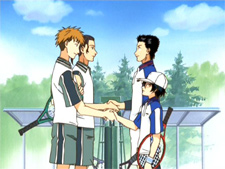 The Japanese cast for The Prince of Tennis is fairly strong overall. Junko Minagawa provides a good balance for Ryoma Echizen’s cocky attitude on the court and occasional emotional moment regarding Sakuno. Momo (Masaya Onosaka) and Sakuno (Mikako Takahashi) are equally well-played, capturing the various degrees of emotion each character goes through in just thirteen episodes. Kohei Kiyasu’s Kaido can be a tad off, though, with trying to simultaneously deliver a line that strikes terror into the other players and “hiss.” The English dub from Salami Studios has some issues which can hopefully be fixed as time goes on. The script tends to waffle between accurate and the ADR writers trying to be clever with some poor results. Direction is also an issue as many of the actors seem to have not fully-grasped their character by the end of disc 3. David Neil Black’s Ryoma often comes off as a bit cold and occasionally flat, failing to capture the character’s cocky nature. Kirk Thornton’s Nanjiro doesn’t go over-the-top enough, which is needed for some of the character’s playful moments. Most of the main cast can equally be singled out for poor delivery in what would normally be a slam dunk for most of the veteran actors hired. Surprisingly, it’s some of the minors who shine, pulling off their brief roles much better than the actors voicing the major characters. Doug Erholtz’s Takeshi Momoshiro is the lone exception, having picked up his character quickly within a couple of episodes. Hopefully the rest of the cast can follow suit during the next box set.
The Japanese cast for The Prince of Tennis is fairly strong overall. Junko Minagawa provides a good balance for Ryoma Echizen’s cocky attitude on the court and occasional emotional moment regarding Sakuno. Momo (Masaya Onosaka) and Sakuno (Mikako Takahashi) are equally well-played, capturing the various degrees of emotion each character goes through in just thirteen episodes. Kohei Kiyasu’s Kaido can be a tad off, though, with trying to simultaneously deliver a line that strikes terror into the other players and “hiss.” The English dub from Salami Studios has some issues which can hopefully be fixed as time goes on. The script tends to waffle between accurate and the ADR writers trying to be clever with some poor results. Direction is also an issue as many of the actors seem to have not fully-grasped their character by the end of disc 3. David Neil Black’s Ryoma often comes off as a bit cold and occasionally flat, failing to capture the character’s cocky nature. Kirk Thornton’s Nanjiro doesn’t go over-the-top enough, which is needed for some of the character’s playful moments. Most of the main cast can equally be singled out for poor delivery in what would normally be a slam dunk for most of the veteran actors hired. Surprisingly, it’s some of the minors who shine, pulling off their brief roles much better than the actors voicing the major characters. Doug Erholtz’s Takeshi Momoshiro is the lone exception, having picked up his character quickly within a couple of episodes. Hopefully the rest of the cast can follow suit during the next box set.
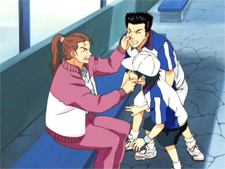 The Prince of Tennis Box 1: The Prince Appears is a large leap into the series for someone who hasn’t had a chance to catch the show on TV yet. Is it a good idea? I would say yes. The nature of the show and its lead character need this thirteen-episode dose to show off Ryoma’s talent on the court and ability to be a bit more normal around people. The large cast for this series presents a lot of interesting personalities to enjoy, and everyone should find someone to cheer for by the end. With the exception of the opening/closing credits (and the use of “Awright!” instead of “All right!” in the subtitles), the DVD box set is fairly solid with a good video transfer and only one major subtitle misspelling. Extras are limited to character sketch artwork and the textless versions of the opening and ending credits on the third DVD. Sports shows take some work to get into, but after the first five to ten episodes you are usually hooked on wanting to see the rest. The Prince of Tennis Box 1: The Prince Appears is a well-priced start to a very big series, and something you should really consider picking up if you’re looking for something new and different to jump into.
The Prince of Tennis Box 1: The Prince Appears is a large leap into the series for someone who hasn’t had a chance to catch the show on TV yet. Is it a good idea? I would say yes. The nature of the show and its lead character need this thirteen-episode dose to show off Ryoma’s talent on the court and ability to be a bit more normal around people. The large cast for this series presents a lot of interesting personalities to enjoy, and everyone should find someone to cheer for by the end. With the exception of the opening/closing credits (and the use of “Awright!” instead of “All right!” in the subtitles), the DVD box set is fairly solid with a good video transfer and only one major subtitle misspelling. Extras are limited to character sketch artwork and the textless versions of the opening and ending credits on the third DVD. Sports shows take some work to get into, but after the first five to ten episodes you are usually hooked on wanting to see the rest. The Prince of Tennis Box 1: The Prince Appears is a well-priced start to a very big series, and something you should really consider picking up if you’re looking for something new and different to jump into.
